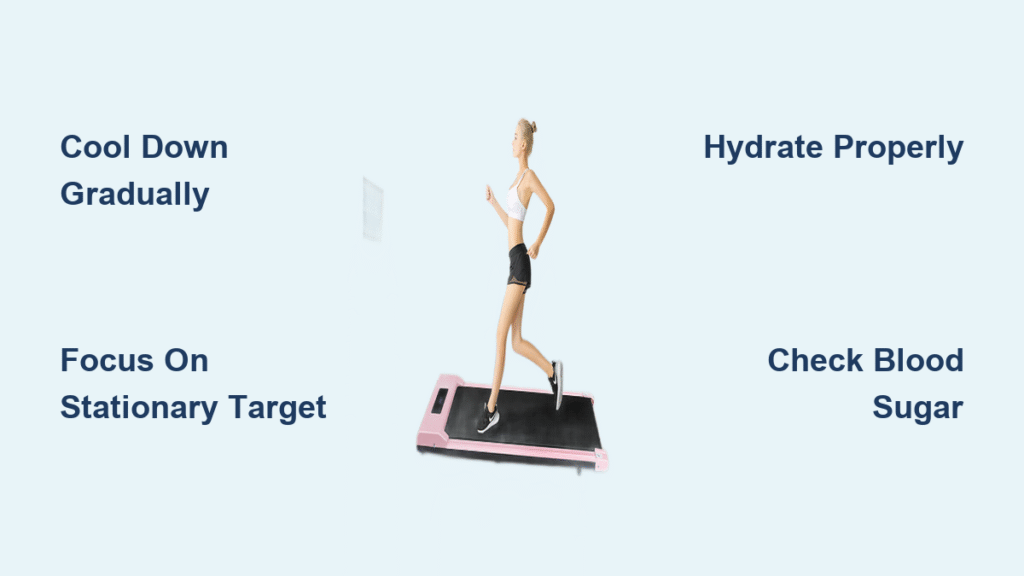You’re powering through your cardio session when suddenly the room starts spinning as you step off the treadmill. That disorienting dizziness after treadmill use can derail your workout routine and leave you feeling frustrated. Nearly one-third of regular exercisers experience this unsettling sensation, but you don’t have to accept it as inevitable. This guide reveals exactly how to stop feeling dizzy after treadmill sessions so you can finish strong and step off balanced.
Dizziness after treadmill use isn’t just annoying—it’s your body signaling a sensory mismatch between your visual system and inner ear. When you run on a stationary machine, your eyes register forward motion from the moving belt while your body remains fixed in space. This confusion creates temporary disorientation as your vestibular system recalibrates. The good news? You can fix this with targeted strategies that address the root causes of treadmill-induced dizziness.
Fix Your Cool-Down Routine Immediately
Reduce Speed Gradually in 5 Minutes
Skipping your cool-down is the fastest way to trigger dizziness after treadmill use. Instead of stopping abruptly, immediately drop your speed to 3.5 mph after your main workout. Continue jogging for 5 minutes while focusing on deep, controlled breathing. Then reduce to 3.0 mph for another 3-5 minutes of walking. Don’t step off until your heart rate drops below 100 bpm—this gives your body time to adjust before dismounting.
Never Cut Short Your Transition Phase
When time constraints tempt you to skip the cool-down for extra high-intensity work, resist the urge. Instead, shorten your main workout by 3-5 minutes to preserve the essential transition period. If you’re extremely pressed for time, never reduce the cool-down below 3 minutes of walking at a comfortable pace. This buffer period prevents the sudden sensory shift that causes dizziness after treadmill sessions.
Master Visual Focus Techniques for Stability

Lock Eyes on a Stationary Target
Your vision plays a critical role in preventing treadmill dizziness. During your cool-down, select one fixed object 6-10 feet ahead and maintain steady focus. This visual anchor helps your brain reconcile the disconnect between perceived motion and actual position. Turn away from TV screens and mirrors that create conflicting visual input. If you need handrail support, use only light contact while keeping your eyes forward.
Implement the 4-7-8 Breathing Method
Combine visual focus with controlled breathing to maximize effectiveness. During the final walking phase, practice the 4-7-8 technique: inhale through your nose for 4 counts, hold your breath for 7 counts, then exhale through your mouth for 8 counts. Repeat this cycle 4-6 times to stabilize your carbon dioxide levels and prevent the hyperventilation that often triggers dizziness after treadmill use.
Optimize Your Hydration Timeline
Pre-Workout Hydration Strategy
Drink 17-20 ounces of water exactly 2 hours before your treadmill session—not right before your workout. Check your urine color; pale yellow indicates proper hydration levels. This pre-hydration approach prevents both dehydration and the bloating that can cause dizziness during exercise. Avoid chugging large amounts immediately before stepping on the treadmill.
During-Exercise Fluid Management
Sip 5-10 ounces of cool water (50-59°F) every 15-20 minutes during your workout. For sessions longer than 60 minutes, add a sports drink containing 300-700mg of sodium per liter to maintain electrolyte balance. Proper hydration prevents the blood pressure fluctuations that contribute to dizziness after treadmill use.
Stabilize Blood Sugar Before Running

Eat the Right Pre-Workout Snack
Fuel your body 1-3 hours before treadmill use with a snack containing 30-60g complex carbs plus 10-20g protein. Try one of these proven combinations: a banana with a tablespoon of almond butter, oatmeal with berries and Greek yogurt, or whole grain toast with avocado. This balanced approach prevents the blood sugar crashes that cause lightheadedness during and after your workout.
Keep Emergency Glucose On Hand
If you experience sudden trembling, weakness, or confusion during your session, these are warning signs of low blood sugar. Always keep glucose tablets (15g fast-acting carbs) nearby to quickly reverse these symptoms. Having this emergency backup prevents the dizziness that often follows blood sugar drops during treadmill exercise.
Adjust Your Environment for Balance
Control Temperature and Airflow
Exercise in climate-controlled environments when temperatures exceed 80°F. Position yourself near fans or air conditioning vents to maintain optimal body temperature. Watch for heat exhaustion warning signs like heavy sweating, nausea, or goosebumps—these conditions significantly increase your risk of dizziness after treadmill use.
Perfect Your Running Posture
Maintain a neutral head position with eyes focused forward—not down at the console. Use handrails for balance only, never for weight support. Start your treadmill at 0.5-1.0 mph and gradually increase speed to allow your vestibular system to adjust. Proper posture prevents the visual-vestibular mismatch that causes dizziness.
Identify Medical Red Flags Immediately
Recognize Serious Warning Signs
Seek immediate medical attention if your dizziness after treadmill use occurs with chest pain, shortness of breath, or fainting episodes. Persistent dizziness lasting more than 30 minutes post-workout or neurological symptoms like confusion or slurred speech require urgent evaluation. These indicators could signal underlying conditions beyond simple exercise-induced dizziness.
Review Medication Side Effects
Certain medications like beta-blockers, antidepressants, and diuretics commonly cause dizziness during exercise. If you started a new prescription around the time your treadmill dizziness began, consult your doctor about potential timing adjustments or dosage modifications to prevent this side effect.
Build Vestibular Resilience with Daily Exercises
Practice Brandt-Daroff Maneuvers
Perform this simple daily exercise to strengthen your balance system: sit on the edge of your bed, turn your head 45 degrees left, then lie down on your right side for 30 seconds. Return to sitting for 30 seconds, then repeat on the opposite side. Complete 5 repetitions twice daily to build vestibular resilience against treadmill-induced dizziness.
Train Gaze Stabilization During Cool-Down
While walking during your cool-down phase, focus on a stationary target while slowly turning your head side-to-side. Gradually increase the speed of your head movements as your tolerance improves. This specific training helps your visual and vestibular systems coordinate better during treadmill use.
Follow This Emergency Response Plan

Immediate Actions When Dizziness Strikes
If dizziness hits while you’re still on the treadmill, immediately pull the safety cord or hit the emergency stop. Sit or lie down right where you are—never try to walk to a chair. Elevate your legs 8-12 inches if you feel faint, and practice slow, deep breathing to restore carbon dioxide balance. Wait until symptoms subside before attempting to stand.
Safe Recovery Positioning
Lie flat with your feet elevated for 5-10 minutes to promote blood flow to your brain. If nausea accompanies the dizziness, lie on your left side to prevent choking. Remain seated for 5-10 minutes after symptoms improve before standing. Never drive or operate machinery until you feel completely normal—this precaution prevents accidents caused by residual dizziness after treadmill use.
Track Your Progress with a Simple Log
Record Key Session Details
After each treadmill workout, note your time of day, session duration, pre-workout food and fluid intake, and cool-down length. Track your dizziness symptoms on a 1-10 scale and record environmental factors like temperature and gym crowding. This detailed log helps identify patterns and triggers specific to your dizziness after treadmill use.
Celebrate These Success Indicators
Look for fewer dizziness episodes each week, shorter symptom duration when they do occur, and increased confidence using the treadmill. Your ultimate goal is maintaining previous workout intensity without dizziness. When you reach these milestones, you’ll know your strategies are working to eliminate that disorienting sensation for good.
By implementing these targeted strategies, you’ll transform dizzy treadmill sessions into confident, productive workouts. Your brain and body will recalibrate properly, allowing you to step off the belt feeling energized instead of disoriented. Master these techniques and reclaim your cardio routine without the frustration of post-treadmill dizziness.




